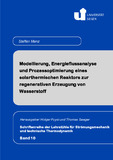Citation link:
http://dx.doi.org/10.25819/ubsi/10461Files in This Item:
| File | Description | Size | Format | |
|---|---|---|---|---|
| Dissertation_Menz_Steffen.pdf | 15.52 MB | Adobe PDF |  View/Open |
| Dokument Type: | Doctoral Thesis | metadata.dc.title: | Modellierung, Energieflussanalyse und Prozessoptimierung eines solarthermischen Reaktors zur regenerativen Erzeugung von Wasserstoff | Other Titles: | Modelling, energy flow analysis and process optimization of a solar thermal reactor for regenerative hydrogen production | Authors: | Menz, Steffen | Institute: | Institut für Fluid- und Thermodynamik | Free keywords: | Wasserstoff, Energieflussanalyse, Simulation, Prozessoptimierung, Hydrogen, Energy flow analysis, Simulation, Process optimization | Dewey Decimal Classification: | 620 Ingenieurwissenschaften und zugeordnete Tätigkeiten | GHBS-Clases: | XIWD | Issue Date: | 2023 | Publish Date: | 2024 | Series/Report no.: | Schriftenreihe der Lehrstühle für Strömungsmechanik und technische Thermodynamik | Abstract: | Der Fokus dieser Arbeit liegt auf der Untersuchung und Weiterentwicklung eines alternativen Verfahrens zur regenerativen Erzeugung von Wasserstoff mittels eines thermochemischen Kreisprozesses unter Verwendung von Metalloxiden in Kombination mit konzentrierter Solarstrahlung. Aufgrund der geringen Anzahl von Prozessschritten liegt die theoretisch erreichbare thermodynamische Effizienz des Verfahrens in einem Bereich von 50 % bis 60 %. In der Praxis wurden bis dato maximale Effizienzen von ca. 5 % bei einem Technologie-Reifegrad (TRL) von 5 bis 6 demonstriert. Zur technologischen Weiterentwicklung bis hin zu einer angestrebten wirtschaftlichen industriellen Anwendung besteht somit weiterer Forschungs- und Entwicklungsbedarf. In einem internationalen Konsortium mit Beteiligung des Deutschen Zentrums für Luft- und Raumfahrt (DLR) wurde eine Pilotanlage mit Verwendung eines thermochemischen Reaktors im 250 kW Maßstab entwickelt, welche in den Forschungsprojekten AS-TOR und ASTOR_ST im Detail untersucht und weiterentwickelt werden. Ziel dieser Arbeit ist die Erstellung eines flexiblen und akkuraten Simulationsmodells der gesamten Pilotanlage zur Analyse und Optimierung von Energiefluss, Reaktordesign und Betriebsstrategie. Um akkurate Simulationsergebnisse zu gewährleisten, werden die Simulationsergebnisse anhand von experimentellen Messwerten der Pilotanlage validiert. Mit Hilfe des validierten Simulationsmodells wird zunächst das komplexe physikalische Systemverhalten analysiert, um neue und detaillierte Einblicke in die dynamischen Prozessabläufe zu gewinnen. Basierend auf der Prozessanalyse werden Möglichkeiten zur potenziellen Effizienzsteigerung erarbeitet. Zur Qualifizierung und Quantifizierung möglicher Maßnahmen zur Effizienzsteigerung wird eine umfangreiche Energieflussanalyse der gesamten Anlage unter Berücksichtigung verschiedener Betriebsstrategien durchgeführt. Im Anschluss wird der Zusammenhang zwischen der Betriebsstrategie und der Anlageneffizienz näher untersucht. Das Ziel hierbei ist die Maximierung der Anlageneffizienz anhand der Ermittlung optimaler operativer Betriebsparameter unter Berücksichtigung verschiedener Anlagenkonzepte. Darüber hinaus soll das Simulationsmodell perspektivisch für eine techno-ökonomische Studie zur Ermittlung der Wasserstoffgestehungskosten sowie zur Echtzeit-Anlagensteuerung im Feldbetrieb verwendet werden. Die Voraussetzungen dazu wurden erfolgreich geschaffen, jedoch im Rahmen dieser Arbeit nicht im Detail erläutert. The focus of this work is on the investigation and improvement of an alternative process for regenerative hydrogen production via two-step thermochemical redox cycles using metal oxides in combination with concentrated solar power. Due to the small number of process steps, highly attractive thermodynamic efficiencies in the range of 50% to 60% can be theoretically achieved. Up to date, maximum practical effi-ciencies of around 5% have been demonstrated with a technology readiness level (TRL) of 5 to 6. Thus, ongoing research and development for further technological development up to a desired economic industrial application is required. In an international consortium with the participation of the German Aerospace Center (DLR), a pilot plant has been developed using a large scale 250 kW thermochemical reactor which has been investigated and further developed in detail within the framework of the research projects ASTOR and ASTOR_ST. In this work, a flexible and accurate simulation model of the entire pilot plant has been developed and used for the analysis and optimization of energy flow, reactor design and operational strategy. To ensure accurate simulation results, the model is validated using experimental measurement data of the current pilot plant. By use of the validated model, first the complex physical system behavior is analyzed to gain new and detailed insights into the dynamic process conditions. Based on the process analysis, several possibilities for potential efficiency improvement are developed. To qualify and quantify possible ap-proaches for efficiency improvement, a holistic energy flow analysis of the entire system is carried out, by taking various operating strategies into account. Furthermore, the interactions of the operational strategy and system efficiency is examined in more detail. The aim here is to maximize the system efficiency by determining optimal operational process parameters, considering various plant concepts. In addition, the simulation model is intended to be used for ongoing techno-economic analysis to determine the hydrogen production costs and for the development of a realtime system control in field test operation. The necessary requirements were success-fully created in this work, but not explained in detail. |
DOI: | http://dx.doi.org/10.25819/ubsi/10461 | URN: | urn:nbn:de:hbz:467-26743 | URI: | https://dspace.ub.uni-siegen.de/handle/ubsi/2674 |
| Appears in Collections: | Hochschulschriften |
This item is protected by original copyright |
Page view(s)
269
checked on Dec 1, 2024
Download(s)
62
checked on Dec 1, 2024
Google ScholarTM
Check
Altmetric
Items in DSpace are protected by copyright, with all rights reserved, unless otherwise indicated.

